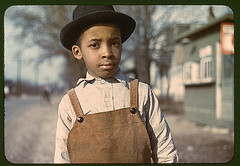SITM and the Organization of Racial History
My reading of “Standards in the Making” (SITM) suggests that metadata and tagging practices should be thought of as a particularly interesting form of knowledge-production. This line of inquiry is prompted by a re-conceptualization of the actual work of tagging and a critique of the assumptions that generally inform the practice. The conventional term—“descriptive metadata”—is here reconceived as a problematic; SITM as a critical practice must inquire into the “work” that description does across information archives. What does metadata “describe” and how do we understand the “affordances and constraints” of the work of description? To answer these questions effectively, we must inquire equally into the semantic history which informs various “descriptive” regimes and the ways in which those (multiple) traditions are negotiated or destabilized in actual descriptive practice to do all sorts of cultural work in the here and now. Folksonomic tagging projects like the Flickr Commons Project, for example, must be considered as both an archive of received social knowledge formations and, simultaneously, as a forum for critical labeling and categorizing practices with unpredictable effects. The question, in the specific context of The Commons’ photo archive, is not what categories and terms aptly describe– what histories and contexts are relevant for a reading of the image-text. Rather, we might ask what categories and terms differently constitute the photo as a historical object, variously conditioning what kind of knowledge it can be.
The Common’s archive contains a particularly well-commented upon photo entitled “Negro Boy near Cincinnati, Ohio” (2008). This image, captured by photographer John Vachon in 1942-43 under the auspices of an FSA/OWI initiative, sharply depicts a young African-American youth set against the blurred field of his poor, seemingly-rural Ohio context. The backdrop of my interest in this particular example is the (predictable) controversy that has sprung up around the title of the image, drawn directly from the original Library of Congress (LoC) catalog title. This controversy, over the appellation “Negro” and its ramifications, has spawned an extensive conversation in the “Comments” section, which, while crude and often polemical, broadly maps the terrain of mainstream black politics of race, representation and history. For scholars in these fields, the terms of this struggle are also thoroughly predictable, ranging across the spectrum of mainstream logics of race from imperatives to colorblindness (“It’s not a Negro boy, it’s a golden boy.”) to appeals to a monumental black history and ethnic pride, to the claim that rational individuals with “a semblance of intelligence” should be able to transcend racial discrimination. Shot through with the claims and conflicts authorized by contemporary multicultural racial formation, the conversations that are archived in the “Comments” section are symptomatic of much larger contradictions in our contemporary conceptions of race (between ethnic pride and colorblindness, for instance)–contradictions that circulate uncritically in a forum built “to encourage healthy debate and community” (Zyrcster, 2009).
There is much more to be said about this, but my goal here is to illustrate how, in turning to collective tagging (as opposed to the collective commenting), we can problematize the terms of this very debate. Simply put, this turn allows us to visualize the label “Negro” not simply as a description of racial identity (one of many which must be submitted to the normalizing impulses of political-correctness), but as an organizing principle which frames the context and “uses” of the concept of race itself. Here I take some cues from Lisa Nakamura’s suggestion that electronic, “collectively authored” images of race (phenomena that she terms “cybertypes”) must be recognized for the ways that they both “stem from common cultural logic” and for the ways that “computer enabled communication can challenge these old logics” (2002, p. 5). Tagging in particular, as a specific type of electronic “communication,” can be read as a site for this struggle, where various “logics” battle to constitute the image as a technical (“slide,” “35mm”), a formal (“selective focus,” “shallow depth of field”), historical (“FSA,” “1940s”), generic (“portrait,” “vintage”), or place-based object (“Cincinnati,” “Hamilton County”). There are also attempts to constitute the photo as an artifact of racial identity, and the previous controversy in the “comments” manifests here in the sheer variety of tags devoted to this purpose. “Black,” “Negro,” and “African-American” all appear alongside other terms like “race” and “americana.” What remains is for us to ask how each of these categories of racial knowledge organize the photo along a different axis and in the name of a different racial logic and how that perspective reflects critically upon the terms of the previous debate.
Exploring these tags – taking note of how they consolidate the archive in idiosyncratic ways – reveals a different set of considerations regarding the construction of racial identity in our contemporary moment. One thing that emerges is institutional practice; only photos from the Library of Congress archive are tagged “negro,” while other archives like the Florida State Library and the Smithsonian, which contain photos that emerge from similar histories and contexts, are tagged “African-American” as a rule.[1] And while many (if not all) of the photos tagged as “negro” are also tagged “African American,” making this the more inclusive set, the “negro” tags are, of course, reserved for a pre-Civil Rights era history, including mainly FSA photos and early 20th century photos of black professional boxers like Jack Johnson. The “African-American” tags range over this history all the way up to the contemporary with representations of Kwanzaa celebrations in the late 80s, for example. Emerging from this reading of the collectively generated metadata are two very different historical projects each with their own forms of memory and forgetting. The first establishes a break—a history that ends sometime in the mid-century and that confines a particular series of racial traumas to a past whose remembrance is preconditioned by historical rupture (that which no longer is and can never be again). The larger category attempts to trace an essential continuity for black racial identity across two centuries of American life, in which the term “African-American” transcends its own traumatic history in the name of a “reiterated American universalism” and happy multiculturalism (Singh, 2004, p. 19). Here, a critical reading of metadata lays bare the assumptions of the previous debate as contradictions on the surface of the archive’s organization and presentation. What was once a debate about an image, walled in by the logics of contemporary political correctness, now becomes a struggle to decide how black, American history is to be organized (and, quite literally, in whose name).
This is a question that a SITM approach allows us to ask even in its most basic iterations – not simply “what is it” but “what are the available categories for knowing it” and “what are the consequences of those organizational principles”? This second question is the one which matters most as we move on to the second half of Nakamura’s ambivalent formulation. Returning to “Negro Boy,” it is crucial to note that the two conceptions of racial history I have described can be visualized as a struggle precisely because they both appropriate the same objects in the name of entirely different uses. As a historical artifact, the photo itself is problematically situated at the intersection of at least two different (if not contradictory) historical knowledge projects set to define the nature of black identity. What becomes absolutely transparent in these intersections is the actual work of historical knowledge-making which involves not simply “digging up” artifacts and placing them accordingly in the container of linear time, but making self-conscious decisions about how that artifact is to be organized alongside others to produce a narrative and an argument about the present. “Tagging,” in instances such as these does not so much “describe” digital artifacts as much as it appropriates them and composes them in the name of more general logics of history and identity. The question that remains (for the new work of composing) is how we might appropriate them ourselves to construct different narratives and, as Benjamin puts it, “brush history against the grain.” What terms will reorganize collective experience and the cultural archive in the name of different stories and identities? These questions, as I have suggested, begin with yet-to-be imagined acts of social tagging.
[1] Searching the terms “black” and “race” are more problematic in this context because they are significantly “looser” as organizing signifiers. Photos tagged “black,” for instance, can also include black & white photography and compositions that are of high contrast alongside pictures including black people. “Race” signifies both the social concept and athletic competition. It should also be noted that to effectively stage this comparison I had to search across possible grammatical variation in each case, looking simultaneously for “negro,’ “negroes,” and “Negro” for instance. Depending on your investment, this issue either gestures towards the problems inherent with language practice against the demands of the semantic web, or simply speaks to the need for more rigorous standards.↑

